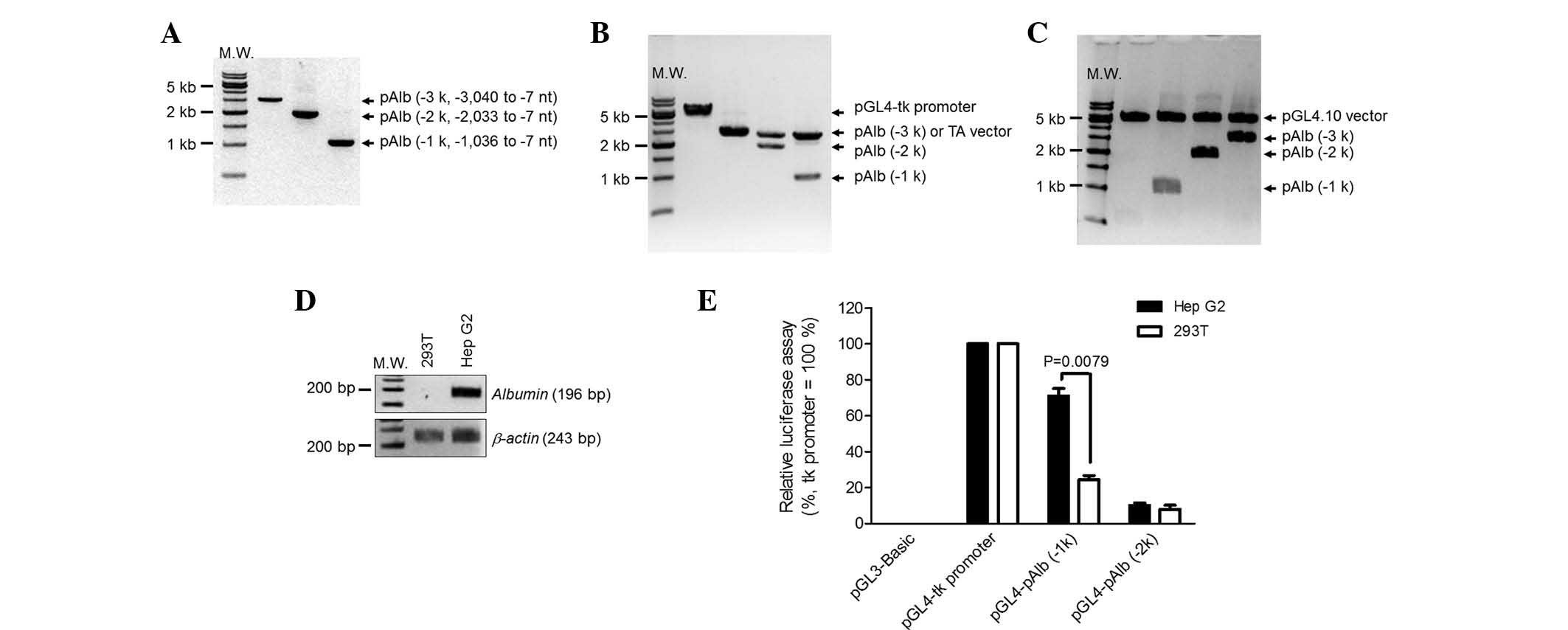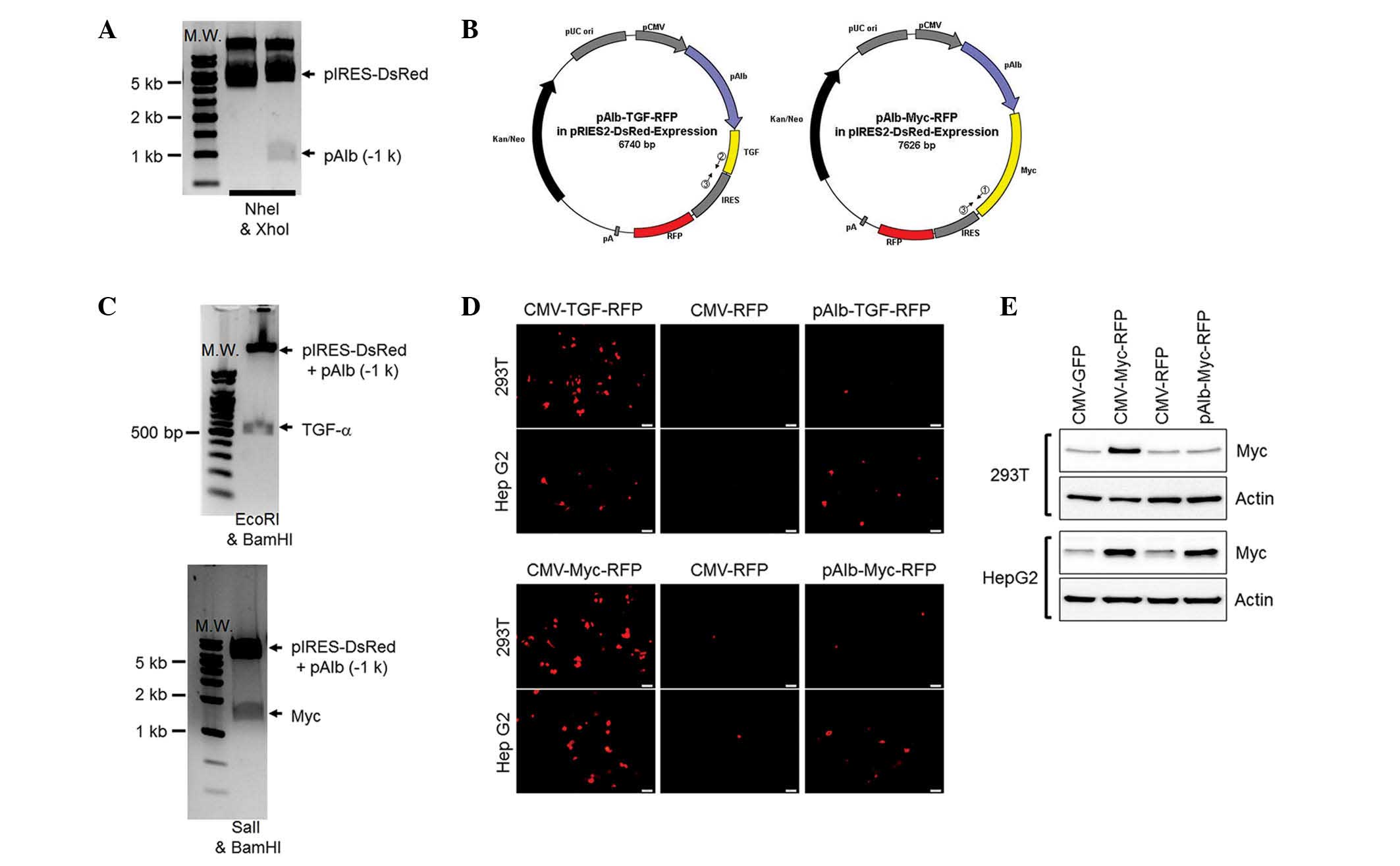|
1
|
Jemal A, Bray F, Center MM, et al: Global
cancer statistics. CA Cancer J Clin. 61:69–90. 2011. View Article : Google Scholar
|
|
2
|
Li Y, Tang ZY and Hou JX: Hepatocellular
carcinoma: insight from animal models. Nat Rev Gastroenterol
Hepatol. 9:32–43. 2011. View Article : Google Scholar
|
|
3
|
Lencioni R: Chemoembolization for
hepatocellular carcinoma. Semin Oncol. 39:503–509. 2012. View Article : Google Scholar
|
|
4
|
Leenders MW, Nijkamp MW and Borel Rinkes
IH: Mouse models in liver cancer research: a review of current
literature. World J Gastroenterol. 14:6915–6923. 2008. View Article : Google Scholar : PubMed/NCBI
|
|
5
|
Dubois N, Bennoun M, Allemand I, et al:
Time-course development of differentiated hepatocarcinoma and lung
metastasis in transgenic mice. J Hepatol. 13:227–239. 1991.
View Article : Google Scholar : PubMed/NCBI
|
|
6
|
Santoni-Rugiu E, Nagy P, Jensen MR, et al:
Evolution of neoplastic development in the liver of transgenic mice
co-expressing c-myc and transforming growth factor-alpha. Am J
Pathol. 149:407–428. 1996.PubMed/NCBI
|
|
7
|
Swindle MM, Makin A, Herron AJ, et al:
Swine as models in biomedical research and toxicology testing. Vet
Pathol. 49:344–356. 2012. View Article : Google Scholar : PubMed/NCBI
|
|
8
|
Jung EM, Kim YK, Lee GS, et al:
Establishment of inducible cAMP early repressor transgenic
fibroblasts in a porcine model of human type 1 diabetes mellitus.
Mol Med Rep. 6:239–245. 2012.PubMed/NCBI
|
|
9
|
Kim YK, Lee GS, Jung EM, et al: Generation
of fibroblasts overexpressing liver-specific PEPCK in a miniature
pig model of human type 2 diabetes mellitus. Mol Med Rep. 6:45–50.
2012.PubMed/NCBI
|
|
10
|
Hann B and Balmain A: Building ‘validated’
mouse models of human cancer. Curr Opin Cell Biol. 13:778–784.
2001.
|
|
11
|
Huff J, Cirvello J, Haseman J and Bucher
J: Chemicals associated with site-specific neoplasia in 1394
long-term carcinogenesis experiments in laboratory rodents. Environ
Health Perspect. 93:247–270. 1991. View Article : Google Scholar : PubMed/NCBI
|
|
12
|
Wogan GN: Impacts of chemicals on liver
cancer risk. Semin Cancer Biol. 10:201–210. 2000. View Article : Google Scholar : PubMed/NCBI
|
|
13
|
Gonzalez FJ: The peroxisome
proliferator-activated receptor alpha (PPARalpha): role in
hepatocarcinogenesis. Mol Cell Endocrinol. 193:71–79. 2002.
View Article : Google Scholar : PubMed/NCBI
|
|
14
|
Williams GM: Chemicals with carcinogenic
activity in the rodent liver; mechanistic evaluation of human risk.
Cancer Lett. 117:175–188. 1997. View Article : Google Scholar : PubMed/NCBI
|
|
15
|
Lee GH: Paradoxical effects of
phenobarbital on mouse hepatocarcinogenesis. Toxicol Pathol.
28:215–225. 2000. View Article : Google Scholar : PubMed/NCBI
|
|
16
|
Chen CJ, Yu MW and Liaw YF:
Epidemiological characteristics and risk factors of hepatocellular
carcinoma. J Gastroenterol Hepatol. 12:S294–308. 1997. View Article : Google Scholar : PubMed/NCBI
|
|
17
|
Hirst GL and Balmain A: Forty years of
cancer modelling in the mouse. Eur J Cancer. 40:1974–1980.
2004.PubMed/NCBI
|
|
18
|
Parkin DM: The global health burden of
infection-associated cancers in the year 2002. Int J Cancer.
118:3030–3044. 2006.PubMed/NCBI
|
|
19
|
Fattovich G, Stroffolini T, Zagni I and
Donato F: Hepatocellular carcinoma in cirrhosis: incidence and risk
factors. Gastroenterology. 127(Suppl 1): S35–S50. 2004. View Article : Google Scholar : PubMed/NCBI
|
|
20
|
Dandri M, Volz TK, Lütgehetmann M and
Petersen J: Animal models for the study of HBV replication and its
variants. J Clin Virol. 34(Suppl 1): S54–S62. 2005. View Article : Google Scholar : PubMed/NCBI
|
|
21
|
Kremsdorf D and Brezillon N: New animal
models for hepatitis C viral infection and pathogenesis studies.
World J Gastroenterol. 13:2427–2435. 2007. View Article : Google Scholar : PubMed/NCBI
|
|
22
|
Buendia MA: Genetics of hepatocellular
carcinoma. Semin Cancer Biol. 10:185–200. 2000. View Article : Google Scholar
|
|
23
|
Colnot S, Decaens T, Niwa-Kawakita M, et
al: Liver-targeted disruption of Apc in mice activates beta-catenin
signaling and leads to hepatocellular carcinomas. Proc Natl Acad
Sci USA. 101:17216–17221. 2004. View Article : Google Scholar : PubMed/NCBI
|
|
24
|
Kitagawa T, Hino O, Lee GH, et al:
Multistep hepatocarcinogenesis in transgenic mice harboring SV40
T-antigen gene. Princess Takamatsu Symp. 22:349–360.
1991.PubMed/NCBI
|
|
25
|
Sepulveda AR, Finegold MJ, Smith B, et al:
Development of a transgenic mouse system for the analysis of stages
in liver carcinogenesis using tissue-specific expression of SV40
large T-antigen controlled by regulatory elements of the human
alpha-1-antitrypsin gene. Cancer Res. 49:6108–6117. 1989.
|
|
26
|
Ahuja D, Sáenz-Robles MT and Pipas JM:
SV40 large T antigen targets multiple cellular pathways to elicit
cellular transformation. Oncogene. 24:7729–7745. 2005. View Article : Google Scholar : PubMed/NCBI
|
|
27
|
Ali SH and DeCaprio JA: Cellular
transformation by SV40 large T antigen: interaction with host
proteins. Semin Cancer Biol. 11:15–23. 2001. View Article : Google Scholar : PubMed/NCBI
|
|
28
|
Alsowmely AM and Hodgson HJ: Non-surgical
treatment of hepatocellular carcinoma. Aliment Pharmacol Ther.
16:1–15. 2002. View Article : Google Scholar
|
|
29
|
Durand F and Belghiti J: Liver
transplantation for hepatocellular carcinoma.
Hepatogastroenterology. 49:47–52. 2002.PubMed/NCBI
|
|
30
|
Maataoui A, Qian J, Vossoughi D, et al:
Transarterial chemoembolization alone and in combination with other
therapies: a comparative study in an animal HCC model. Eur Radiol.
15:127–133. 2005. View Article : Google Scholar : PubMed/NCBI
|
|
31
|
Poon RT, Fan ST, Tsang FH and Wong J:
Locoregional therapies for hepatocellular carcinoma: a critical
review from the surgeon’s perspective. Ann Surg. 235:466–486.
2002.PubMed/NCBI
|
|
32
|
Tang ZY: Treatment of hepatocellular
carcinoma. Digestion. 59:556–562. 1998. View Article : Google Scholar : PubMed/NCBI
|
|
33
|
Buscarini E and Buscarini L:
Radiofrequency thermal ablation with expandable needle of focal
liver malignancies: complication report. Eur Radiol. 14:31–37.
2004. View Article : Google Scholar : PubMed/NCBI
|
|
34
|
Denys AL, De Baere T, Kuoch V, et al:
Radio-frequency tissue ablation of the liver: in vivo and ex vivo
experiments with four different systems. Eur Radiol. 13:2346–2352.
2003. View Article : Google Scholar : PubMed/NCBI
|
|
35
|
Lee JM, Lee YH, Kim YK, et al: Combined
treatment of radiofrequency ablation and acetic acid injection: an
in vivo feasibility study in rabbit liver. Eur Radiol.
14:1303–1310. 2004.PubMed/NCBI
|
|
36
|
Sturm JW, Keese MA, Bönninghoff RG, et al:
Locally ablative therapies of hepatocellular carcinoma. Onkologie.
24(Suppl 5): 35–45. 2001.(In German).
|
|
37
|
Achenbach T, Seifert JK, Pitton MB, et al:
Chemoembolization for primary liver cancer. Eur J Surg Oncol.
28:37–41. 2002. View Article : Google Scholar : PubMed/NCBI
|
|
38
|
Llovet JM, Real MI, Montaña X, et al;
Barcelona Liver Cancer Group. Arterial embolisation or
chemoembolisation versus symptomatic treatment in patients with
unresectable hepatocellular carcinoma: a randomised controlled
trial. Lancet. 359:1734–1739. 2002. View Article : Google Scholar
|
|
39
|
Vogl TJ, Trapp M, Schroeder H, et al:
Transarterial chemoembolization for hepatocellular carcinoma:
volumetric and morphologic CT criteria for assessment of prognosis
and therapeutic success - results from a liver transplantation
center. Radiology. 214:349–357. 2000.
|
|
40
|
Writing Group Members. Lloyd-Jones D,
Adams RJ, Brown TM, et al; American Heart Association Statistics
Committee and Stroke Statistics Subcommittee. Heart disease and
stroke statistics - 2010 update: a report from the American Heart
Association. Circulation. 121:e46–e215. 2010. View Article : Google Scholar : PubMed/NCBI
|
|
41
|
Swindle MM, Smith AC and Hepburn BJ: Swine
as models in experimental surgery. J Invest Surg. 1:65–79. 1988.
View Article : Google Scholar : PubMed/NCBI
|













